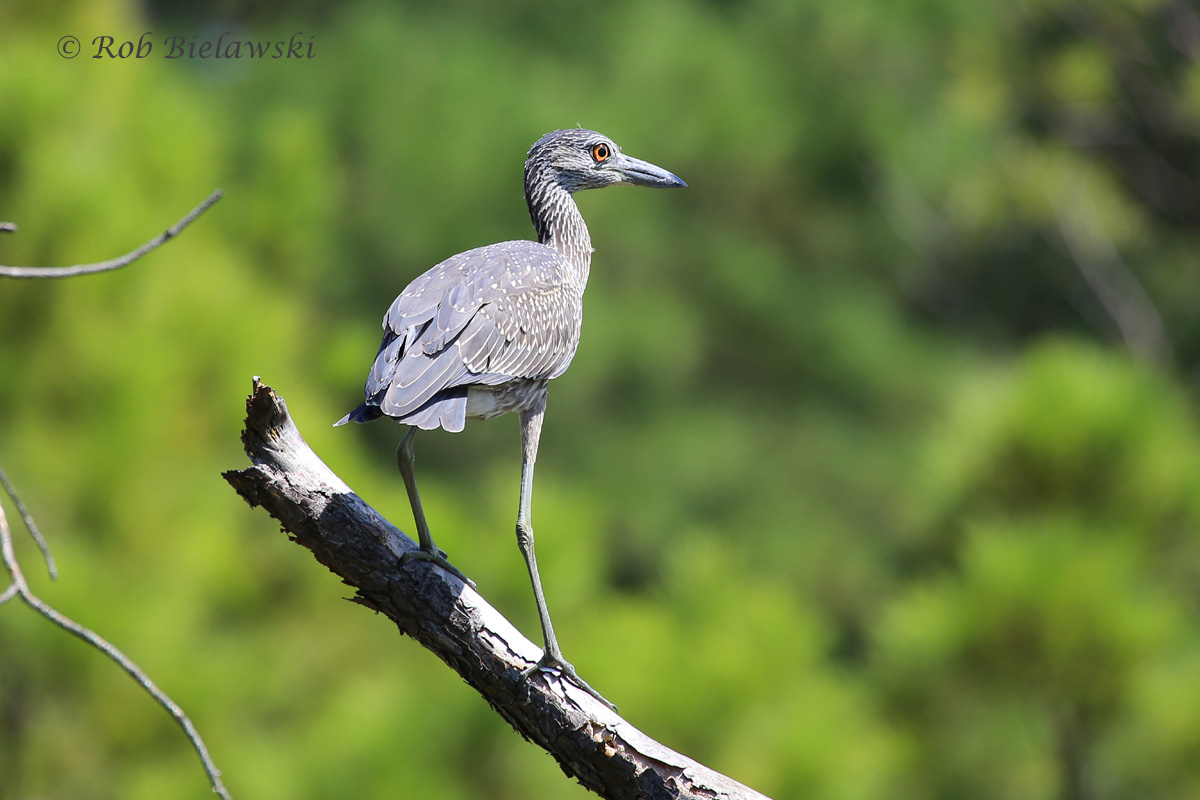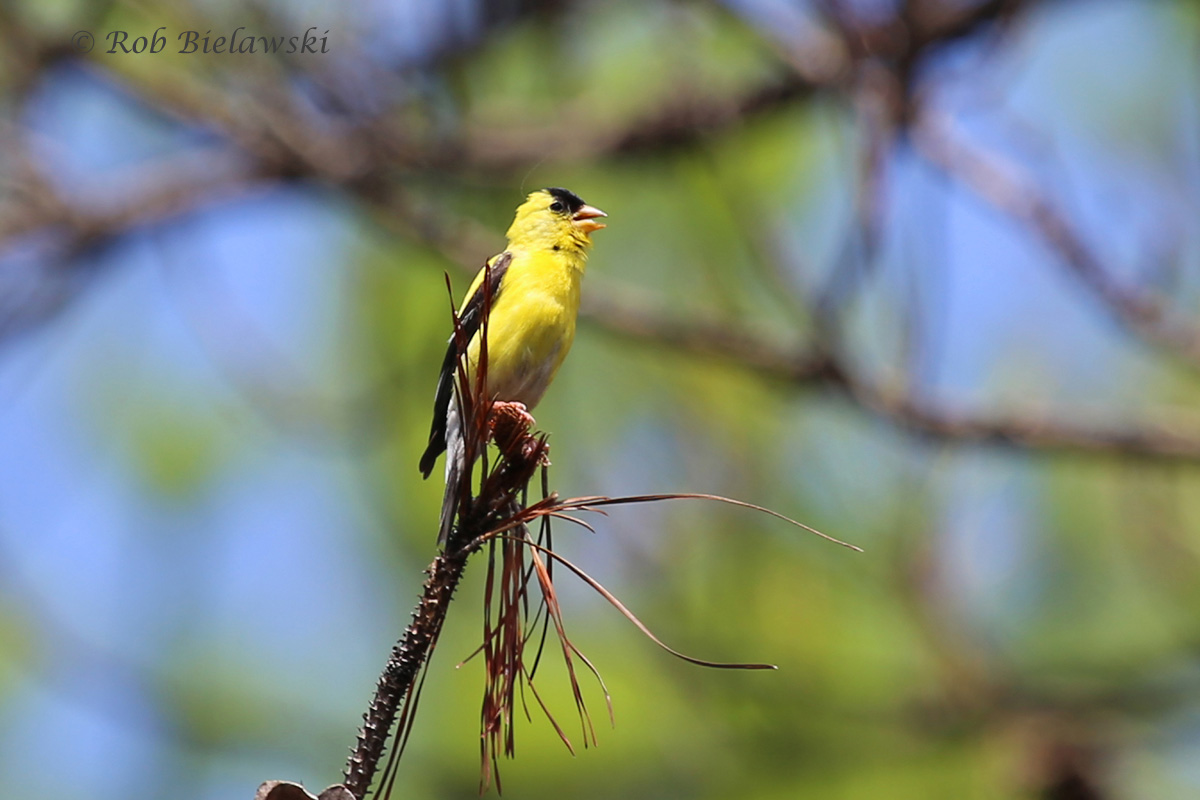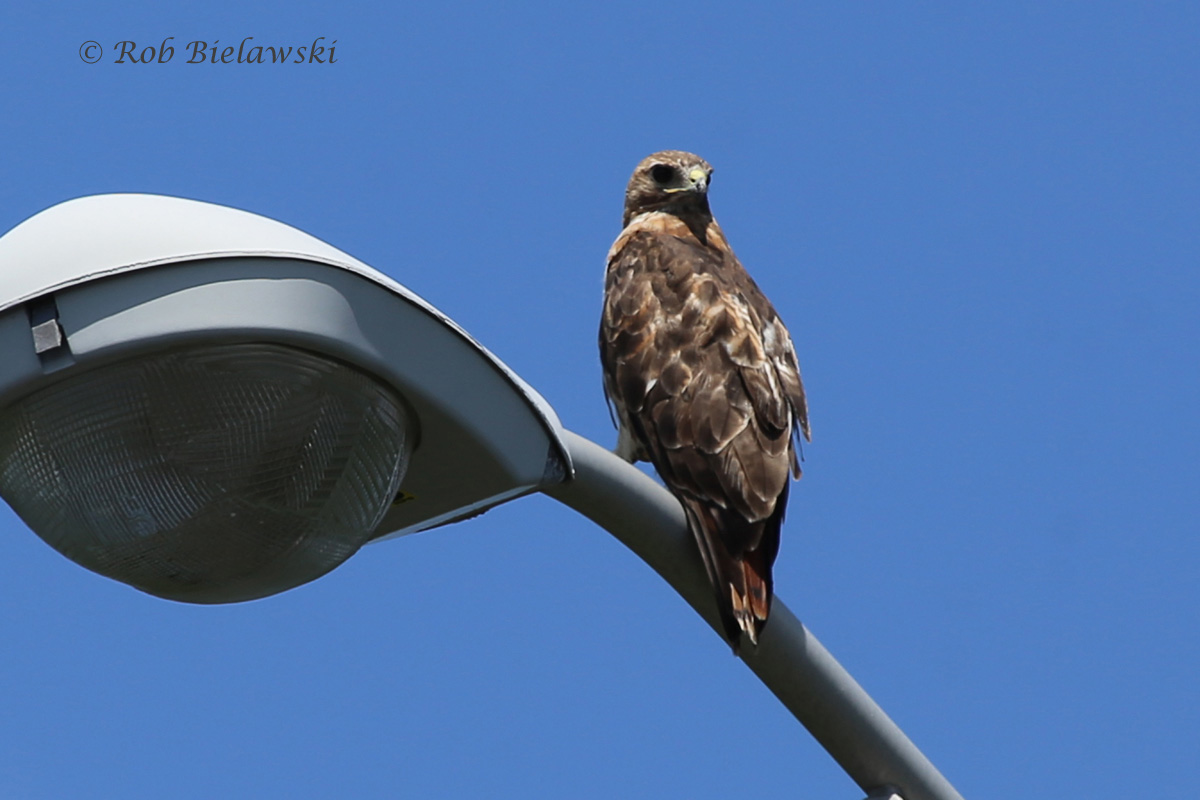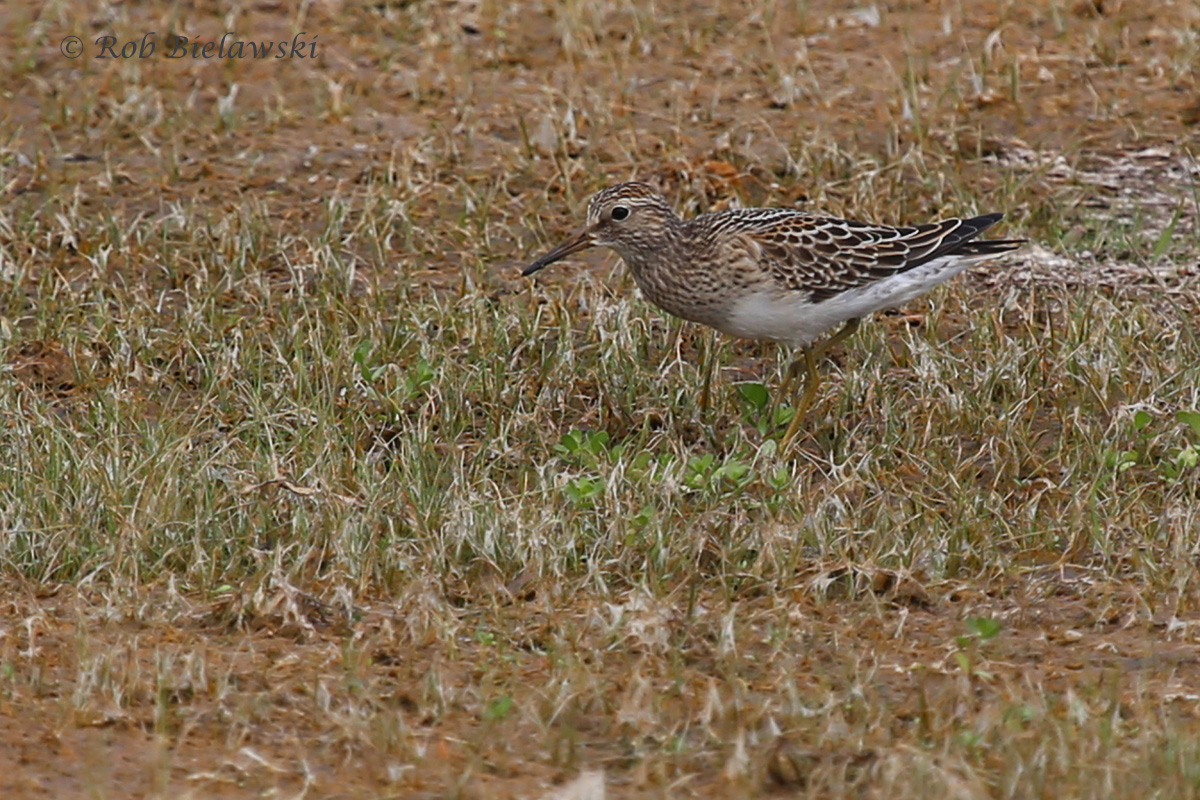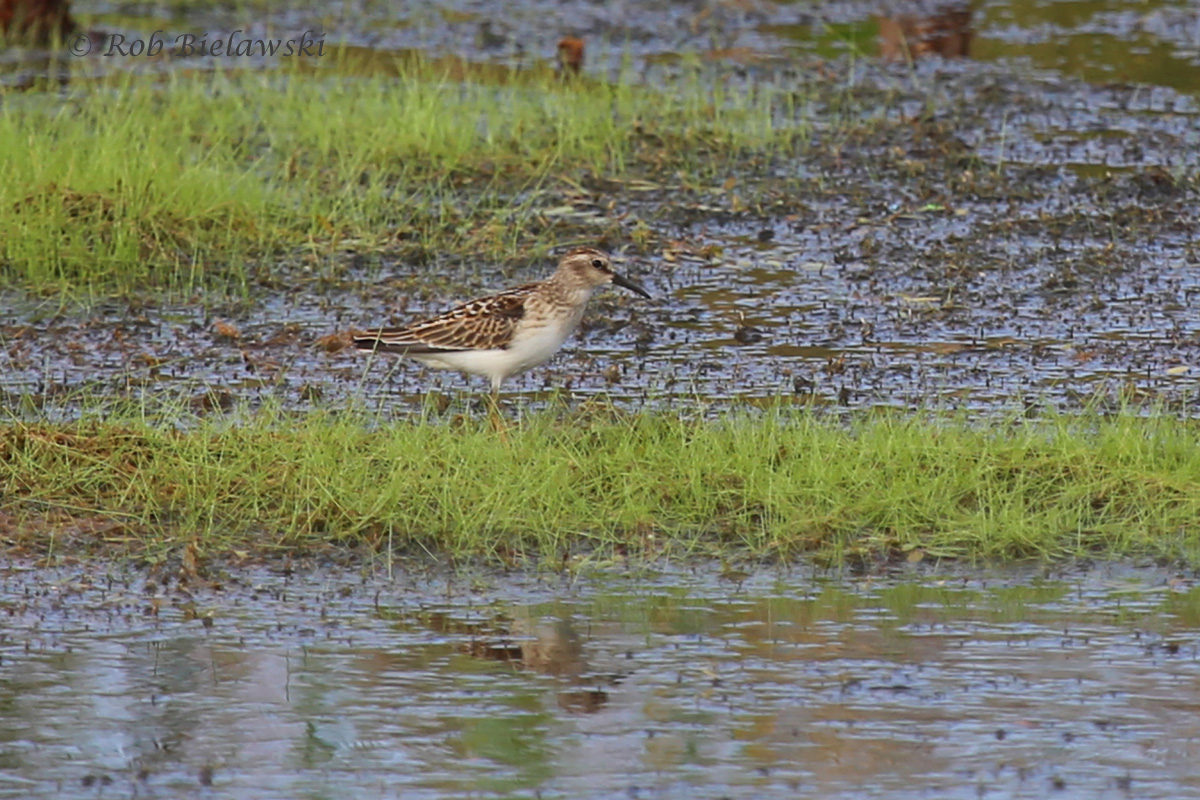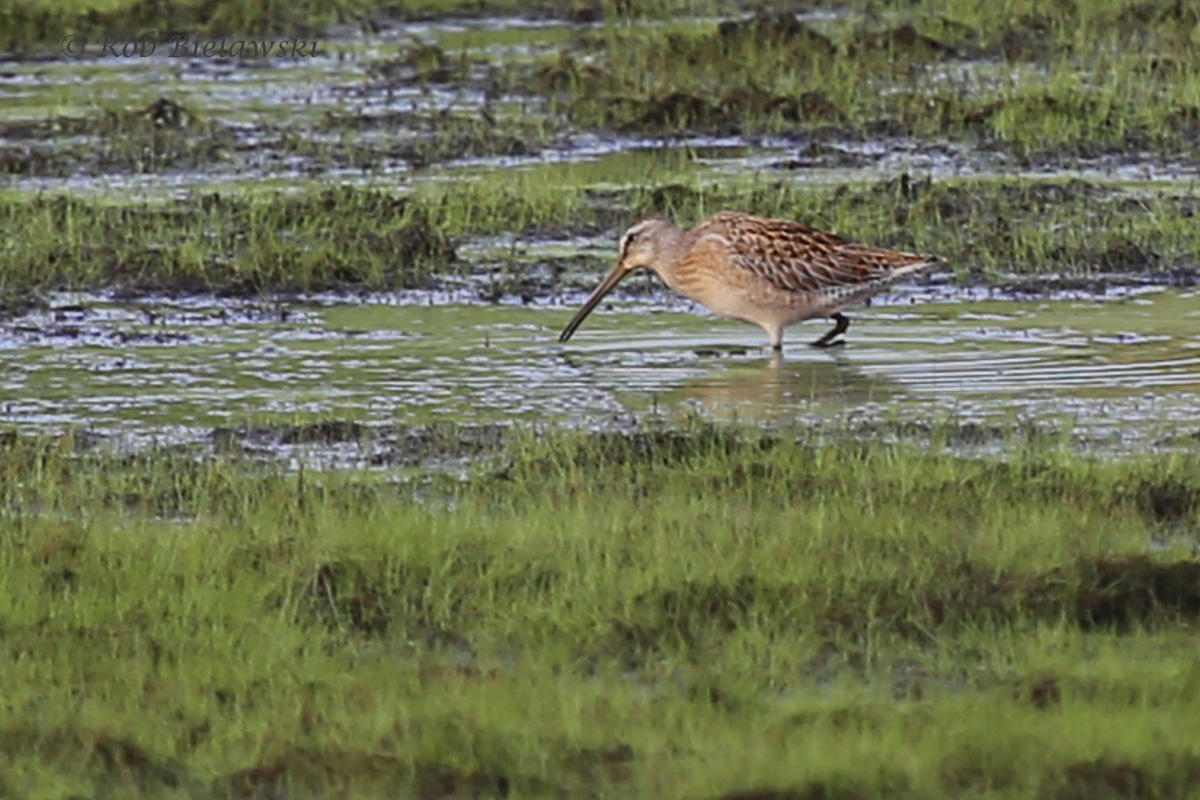Week Ending September 13, 2015
/Since Monday was Labor Day, and a holiday for my company, I got the pleasure of spending the whole day out birding. Early on Monday morning I met up with Jason Strickland out at Back Bay National Wildlife Refuge, around 7:40 AM, though he'd arrived earlier in the park. We walked the Bayside & Bay Trails hoping to find a few migrant warbler species, but came up empty in those areas of the park. The waters of the bay near here were also very quiet and we didn't see any Pied-billed Grebes or waterfowl species though it is still very early in the season. The Bay Trail held a couple of Northern Cardinals, some overhead Red-winged Blackbirds, with some unidentifiable shorebirds passing over as well, but that was essentially all the activity we had. Arriving back at the southern parking area, we turned south and headed down the Loop Road's eastern side en route towards the East Dike Trail which is open this time of year while the West Dike Trail is closed. I had wanted to walk the beach to see if any Godwits might have been out, since I'd seen one last year this week, but with the sun still low on the water, walking the East Dike down and the beach back gives it some time to get higher in the sky so it doesn't obscure the views towards the waterline. Along the Loop Road we spotted a Yellow Warbler and at least a pair of American Redstarts in the scrub off to the east after hearing the sound of a White-eyed Vireo and stopping for a while to investigate. Carolina Chickadees were also seen in this spot. Typically Prairie Warblers are common in this area, and today was no exception, with a pair of them flitting about at the top of a Live Oak tree on the west side of the road. Along the East Dike Trail it was my hope that some lingering shorebirds might still be found at the double-90 degree bend about midway to False Cape SP, but upon arrival, this spot was devoid of any birds. Just a couple weeks ago it was teeming with shorebirds, dominated by Semipalmated Plovers but with one Pectoral Sandpiper out there as well. Unfortunately it seems as though the shorebird migration through our area has really tapered off.
On the C-Pool there was at least one Little Blue Heron adult visible, with a white bird to its side that could have been either a Snowy Egret, though it wasn't actively feeding, or a young Little Blue Heron, but unidentifiable with any certainty. Also, one Greater Yellowlegs could be picked out, but the other birds visible were just too far out. The West Dike Trail would have afforded much better views, but this will not be open again until next April/May. Further south, along the next similar mudflat area on the duneside of the trail, we did get 2Spotted Sandpipers, and got to watch one of them in fluttery flight. Heading into False Cape State Park, the birds were pretty scarce, but one rather large Eastern Cottonmouth made for some excitement as it crossed the gravel roadway just north of the visitor center. More White-eyed Vireos were heard along the Barbour Hill Trail leading through the woodlands towards the dunes, and one gave a split second look as it dove down into the lower brush just prior to the campsites. The dunes were incredibly hot & humid as was expected, but reaching the ocean's breeze was rejuvenating. A few fisherman were scattered to the south, so no birds were in sight in that direction. Heading northward back towards Back Bay, we had a Caspian Tern and a few Royals, as well as some Sanderlings and Great & Lesser Black-backed Gulls on the beach. Traveling up the Back Bay portion of the beach, we were mainly seeing the same birds out over the water with Caspian, Royal Terns, and Ring-billed, Laughing (mostly juveniles), Great & Lesser Black-backed Gulls, though we did find a single Herring Gull as well. No Sandwich Terns were observed with certainty, though we had a couple cross quickly by us that could have been. A single Forster's Tern was also seen on the beach, and it flew off a couple times out in front of us, only to land in our path once more. The highlights along the beach actually came relatively far north, closer to the parking areas of Back Bay, where we added a few Black-bellied Plovers, with one beautiful juvenile bird that had me staring intently at it for a few moments to discount American Golden-Plover due to its skinniness. Also, we came upon one Whimbrel just a few hundred yards south of the Seaside Trail access to the beach.
This was likely the same Whimbrel that many others have observed over the past week or so in the same general area. As with the southbound trip, on the return journey the marshy patch next to the parking area was empty of any shorebirds, also having been a hotspot a week or so ago. No Piping Plovers were noted on this outing, and the only birds we saw at the higher side of the beach were Mourning Doves, and a few Barn Swallows flying along northward. After leaving Back Bay, Jason followed me over to Princess Anne Wildlife Management Area’s Whitehurst Tract to do a quick look around for migrating songbirds. We both parked and walked down the main road, searching the treeline for birds. After a quarter mile or so though, my legs were essentially done from the 10 miles we’d already walked, and so we headed back to the car. Hearing a strange sound that he thought might be a turkey, we investigated, but found it to be a young Blue Jay instead. Several Chipping Sparrows and Carolina Chickadees were seen flitting about in the trees near the road, but nothing out of the ordinary for this point in this season. What was nice to find out though, is that the farmfields along Morris Neck Road are starting to be cultivated, so these will likely hold some migrating shorebirds if we get heavy rains in the near future. Since songbird migration is starting to get going, I tried stopping off at a park in my neighborhood on the way home to see if I could locate any more warblers (like the Black-throated Blue Warbler seen on Sunday morning of last week). However, the only birds that were around was a few American Robins, and a Double-crested Cormorant circling extremely high up.
On Wednesday, after work had ended, I ran home and grabbed my gear and checked out a couple parks in Kings Grant. The first spot I went too was Middle Plantation / Bishop’s Gate Park located of Little Haven Road in Little Neck. I am truly not a fan of this style of birding, that is to say, standing around city parks with playgrounds just because there are tall trees that can hold warblers. I always feel like a weirdo standing in these areas with binoculars & a telephoto lens, but, this time of year, any park available can yield migrating warblers and it tends to be just a matter of being at the right one at the right time. Walking around the asphalt bike path that splits the park, I didn’t see a single bird moving around in the canopy. I did see a Red-tailed & a Cooper’s Hawk soaring high overhead though, but no Red-shouldered Hawks of course. So I spent about 20 minutes there in total, then I stopped at Kings Grant Lake Park, where Ron Furnish & Marie Mullins had spotted a Black-and-White Warbler a few days prior. This bird, an adult female, was still there, and it took just a few minutes to find it as it worked through the branches on the larger trees in the center of the park. I took a ton of photographs of this bird, and was able to get some nice ones after it had captured a caterpillar of some sort and then devoured it. It tried to stick to the tops of the branches to obscure my view, so I ended up having to get right against the tree’s trunk on some exposed roots, and stand on my toes to get a slightly better angle for photography. After watching around for other warblers in the treetops, and finding none, I headed back home for the evening. On Thursday after work I decided to check out the area I’d seen the Black-throated Blue Warbler just in case something else had shown up during the week. Once again though, this forested patch was very quiet, with just a Red-bellied Woodpecker and a few American Robins being sighted. This spot seems to have everything necessary for warblers, but perhaps it just too early still in the season, or perhaps it is too close to developed areas. Whatever the reason, so far that Black-throated Blue has been the one gem to come out of my trips here.
On Friday evening, I got out for my standard post-work hike. This week, there was a lot of excitement at Back Bay NWR, as Karen Beatty & Mary Catherine Miguez both posted photographs of a Northern Waterthrush seen along the Bay Trail. A few days earlier, Bill Oyler had reported it, and then later Jim Marcum also saw it. In addition to this bird, Bob McAlpine had posted a Cape May Warbler photograph into the HRWE group on Facebook. So with these two species being seen, I had figured Friday evening that was where I would be heading. However, I was getting reports during the day from Karen via Facebook, and it was much quieter there due to some rain bands that passed through in the morning. Because of this, I decided instead to go up to First Landing State Park to check for migrating songbirds, just as I had done the previous Friday. With shorebird migration essentially ending, I can now focus my efforts in the forests, looking for songbirds as their migrations ramps up, and soon, the raptors, and then waterfowl will begin their own journeys south. For now, I need to pick up as many species of transients (those species that pass through our area, but neither winter nor summer here, and are only seen traveling between their wintering ground further south of us, and their breeding grounds further north). So I headed up to First Landing at 3 PM, arriving about 3:20 PM at the 64th Street entrance. The nice thing about this entrance is there is parking outside the park on the street, so you can park and walk in without paying the entrance fee. First Landing is the most visited park in the state of Virginia, so I don’t feel bad about doing this either, it sees millions of visitors each year. Walking into the park and heading southwest down the Cape Henry Trail, I got my first bird, an Osprey that was sighted overhead up through the canopy. A close second was a Blue-gray Gnatcatcher, a bird I don’t see too often in the park. Carolina Chickadees and Brown-headed Nuthatches were seen along the trail, and a Red-headed Woodpecker was also making quite a raucous in a tall, dead tree as I got closer to Lake Susan Constant. At the north edge of the lake, Pine Warblers were hopping all over the place, and I was able to photograph a few of them, along with a Downy Woodpecker, before heading up the road to the start of the Long Creek Trail.
The trail was very quiet, until I reached the old junction of the Osprey & Long Creek Trails. Here, a few birds were seen overhead, high up in the forest canopy, and after a few minutes of working into a good spot with the sunlight, and some luck, one of them came into view just long enough to identify as Baltimore Orioles, a new addition to my County Big Year, #188! At least 4 of the birds were seen, but they quickly flew off deeper into the forest, staying high up in the treetops. I did get an identifying photograph showing their bright white wing bars, and overall orange colors, but they were quite drab still in their fall plumage. From there I walked the Osprey Trail to Broad Bay and back, as I’d done the previous Friday as well. Along the trail, I had a nice surprise when a Red-eyed Vireo hopped into view in a short tree, and actually gave me one decent photograph. Typically these birds have been very difficult to capture with the lens, hiding high up in the canopy. That was essentially the only bird I saw along this patch of trail though, and I didn’t spot any transient warblers like I had last week with the Black-and-White and American Redstart. On my way back east on the trail, I did pick up another Ovenbird, likely the same one I’d seen the previous week as it was right in the same area. But, again, I managed not to get a shot of this one since it was quick to retreat to the forest floor and hide from view. Walking around Lake Susan Constant, a Belted Kingfisher was heard, and then seen flying low above the water, and repeatedly crashing into it. I’ve never seen one actually hunt this way, perhaps it was just trying to take a bath. Also in the area, another Baltimore Oriole flew into view, landing on a branch high up in a tall Yellow Pine tree. I realized quickly why the bird had flown from its previous site, as a Peregrine Falcon appeared, and sailed into the patch of canopy where it had been. I watched the Peregrine for about 20 minutes, hoping it would come out into better view, or take off, and afford me some flight shots before it reached top speed. However, it stayed put and so I continued on without good photographs. One bird was seen hopping around it in the tree, about oriole size but not looking the same, so I’m unsure of the species. It was funny to think that the small birds can get away with harassing the falcons when they’re stationary, but that same bird would be dinner if it tried to harass the high speed dynamo in flight. This outing was the first in which I noticed just how much earlier the sun is starting to set around here. Though, I was in the forest, so the light starts to disappear even earlier due to the trees blocking it out, by 5:45 PM when I had exited the forest, it was getting quite dark, and it’ll only get worse as the days go on unfortunately. However, I’m quite looking forward to winter, when I can work on my website without being out hiking every day of the week, things calm down a lot when the sun sets while I’m still at work!
With the addition of the orioles on Friday evening, I was feeling quite good to start Saturday morning. I got an early start, heading to Back Bay NWR and arriving just before 7 AM! The weather forecasts were all calling for a complete washout for the weekend, but it looked as though the rain might hold off for a couple hours in the morning, which is why I wanted to get there so early. That, and the warblers that migrate through tend to be much more active early in the morning as opposed to later in the day. So as soon as I got there, I set off down the Bay Trail, walking slowly, being careful to look for any signs of movement in the trees. Carolina Chickadees and American Robins were in motion along the trail, and by the time I was about halfway out, I spotted a Yellow Warbler up in a dead tree on the south side of the trail. Continuing slowly around the boardwalk portion of the trail I spotted a couple of Baltimore Orioles up in another dead tree, and they were joined by more robins. I think it is funny that the orioles were a species I had never seen in the county until Friday, and not even 24 hours later I added more of them to my list. When I’d reached the end of the Bay Trail, I was in for quite an alarming sight as the skies now visible to the south over the bay were an ominous black color, and moving my way. I figured I had about a half hour before the skies let loose on me so I headed back towards the car. However, near the shoreline of the large pond, where the memorial placard is placed, I caught a quick bit of motion, and got about a 2 or 3 second view of the Northern Waterthrush as it jumped into the open! While raising my lens to get a photograph, it jumped off its branch and flew west across the trail, then banked to the north and disappeared. I was a bit bummed I couldn’t photograph the bird, but seeing it up close still allows me to add it at #189 for my County Big Year!
Right after this, two birders approached down the boardwalk, and I recognized Donald Freeman immediately, having conversed many a time in the HRWE group on Facebook. His friend, Dennis Tompkins was also a member, but someone I wasn’t familiar with since he doesn’t post often. We chatted for about 15 minutes, and I then departed to try to make it back to the parking area before the rain dumped. I failed in that endeavor, as I was just about half way back when the rainfall began, slowly at first, then to a steady downpour. I jogged the remainder and hopped in my car to sit the storm out. Amusingly, another car was parked two stalls to my right, and as the rain appeared to let up a bit, I rolled the window down, as did the other driver, who I recognized as Mike Collins, another HRWE member that I’d never met, but you can’t help but see their profile photos when they post in the group, so the faces stick with me in much the same way that even birds I haven’t seen before are readily identifiable since I’ve seen them in field guides so many times before. He said the radar was showing the storm lasting a bit longer, so we kept waiting. Donald & Dennis eventually made it back to their car, 2 stalls to my left, soaking wet of course, and they opted to not wait out the rain and instead left the park. After they left, another car pulled into the spot immediately to my left, easily recognizable as Betty Sue & Ken Cohen, who I seem to be running into almost every outing the past few weeks. So the three cars all sat out the rain, and when it did stop about 45 minutes after starting, the 4 of us walked the Bay Trail again together. Incredibly, the birds were out and singing as soon as the rain stopped, and at the first clearing, we got several American Redstarts and Yellow Warblers up in the trees. We ended up walking the trail two times as a group, so I can’t recall exactly on which trip we saw which birds, but we did add a Black-and-White Warbler, a beautifully colored male, as it flew over us and then landed up in a tree.
We also were treated to a single River Otter diving and surfacing repetitively off the overlook at the end of the Bay Trail. Yellow Warblers, and Common Yellowthroats were the most common birds along the Bay Trail though, and we also saw some more Baltimore Orioles. Betty Sue was racking up life birds on the outing so it was neat to be in a position where I could actually help a newer birder out. 99% of the time I’m out birding alone, so I’m 100% focused. With having others around, it becomes a bit harder to focus completely, but it does also lend more eyes and ears to the cause. Unfortunately, after a half hour or so of walking the trail, the inside of my lens completely fogged up and I couldn’t use my camera for an hour and a half until it cleared itself. I think when I had the lens opened up at Canon a couple weeks back to be cleaned, that they didn’t vacuum seal it properly. Some moisture from the rainfall must have seeped into it, and the sunshine that followed must have caused it to evaporate and condensate on the inner lens. It sure was a helpless feeling though, with no means to clean the inside off, and it just becoming useless. When it cleared though, I started shooting again, though I missed a few great shots of Eastern Cottonmouths, Yellow Warblers, American Redstarts, and the Black-and-White Warbler…and a Green Treefrog. After walking it twice as a group, Betty Sue & Ken headed over to another section of the park, and Mike & I walked over to the E-Pool to check for shorebirds. Only a Great Blue Heron, a few peeps (likely Leasts) were visible, and one Semipalmated Plover was sitting way at the back side. Here, three White-tailed Deer were also seen as they walked right across the now fairly dry marshy patch. Since my camera wasn’t working at the time, I pulled my cell phone out and actually got a video of the deer, and a couple still shots, though, I’d take my camera over that method any day. After the marsh, we walked the Bay Trail one more time, though not adding anything new, and not finding the Waterthrush again. We did see a few Yellow-billed Cuckoos, which was a bird Betty Sue was trying to find. So, when we finished our hike, and the Cohen’s were again right back at the base of the trail, I walked one additional trip with them to see if I could get her a cuckoo. Of course this time, we didn’t see any cuckoos. Again I arrived back to the start of the trail, and this time, Ron Furnish & Marie Mullins were there looking for warblers, so I walked a trip out and back on the trail with them. I think I ended up walking about 5 miles just on the Bay Trail, something I never do, but each time seeing less and less birds as the day went on. I ended up heading out from the park after noon, so after 5 or more hours of being there searching out warblers. Fortunately, I added the waterthrush, but I still wished I could have gotten a photograph.
On Sunday morning, the weather was an exact repeat in that it was supposed to be a washout after about 7 AM, so I again made a dash first thing in the morning to Back Bay, arriving at 6:50 AM this time. This time though, the temperature was actually only in the 60s (F) when I first got out of the car, much cooler than we’ve had in recent days. It was really the first day that felt like Fall to me, ironically the NFL also had their first Sunday games today, so football and Fall always seem to go hand in hand. But, back to the birding, I walked the Bay Trail immediately as I had done on Saturday. Right off the bat, I spotted what I assume were the same 3 White-tailed Deer that I’d seen Saturday, this time near the bench along the Bay Trail, providing me some nice photographs. Walking slowly, I again knew I was the first one down the trail since I kept walking through spiderwebs that hadn’t yet been broken by anyone else. This is the summertime’s version of seeing footprints ahead of you in the snow during winter. Birds were quiet. My second observation was that the waters of the bay were extremely high, and could be seen in the normally dry areas to both sides of the Bay Trail. The persistently strong southwestern winds we’ve had over the last couple of days have pushed the waters of the bay northward, inundating this section of the shoreline. Because of the southwestern winds, I also thought that perhaps the warblers seen yesterday would have remained here since they wouldn’t want to continue on their southward migration with a strong headwind slowing them down. The walk westward on the Bay Trail though, seemed to tell a different tale, as I didn’t see a single bird until just before reaching the spot where I’d seen the Waterthrush Saturday.
This one though, was not the same bird but I instantly recognized it through the thick cover as an adult female Black-throated Blue Warbler! It was just one week ago to the day that I finally added this bird to my life list, so it was pretty neat to see another one on this outing. It just continues what I always say about life birds, once you add them, it is like they become much more accessible to you, and will start showing up more and more. I don’t know if it is because you’ve got the confidence in identifying one properly after having worked through the first or what, but it isreally uncanny how it can take 30 years to find a bird, then the next week you’ll see another of the same species. I was able to snap some photographs, since my camera was again clear of fog this morning, and performed properly throughout the day as it should. Hopefully it continues to do so. Walking back east on the trail, I picked up an American Redstart about midway to the connector boardwalk to the Bayside Trail, but this was the only other bird I managed to find on the trail. I did have a Marsh Rabbit with very wet fur from the high waters, stop on the trail and give me some more photographs before jumping back into the watery environment they call home. These are the rabbits that are quite adept at swimming, though I’ve only seen it once, it was quite a sight to behold. After not doing so well on the Bay Trail, I recalled how Jim Marcum had a Northern Bobwhite last Monday near the parking area, and how earlier in the winter, Ron Furnish also had an American Woodcock in the same area. So, I figured, I might as well check around the parking area for birds, and boy am I glad that I did! Passing around the visitor center, I walked up the east side of the parking area, and began to see some birds in the treeline about 50 feet east of a small wooden fence that I felt I needed to stay on the parking lot side of.
Brown Thrashers, Northern Mockingbirds, and Gray Catbirds were the first birds, so nothing too exciting since all are year-round residents, and quite common in the park in any season. But, the longer I watched shrubs, the more activity I could see. And then, I spotted something that got the heart pumping. A small sparrow landed on a branch, showing a strong central chest spot, like a Song Sparrow would have, but it did not have the facial markings of a Song, and instead, it was a Lark Sparrow, a life bird, and #190 for my County Big Year!! It hopped from branch to branch, then to my amazement, flew closer and landed on the ground where I could get better photographs of it with the green grass and gray branches as a background rather than the overcast skies that tend to such all the color of birds. I watched it for about 5 minutes before it flew back into the shrubs, and I didn’t see the bird again. About this time, I texted Ron Furnish, and send a message to Karen Beatty as well alerting them to its presence. Ron was planning to come down in a little while, and I didn’t think about til afterwards, but Karen was probably at or on her way to church. After sending out word, I walked the Kuralt Trail, hoping to add some more birds. Along the trail here I got a Yellow-breasted Chat, some Carolina Chickadees, a few Blue Grosbeak females, and a pair of Pied-billed Grebes just off the overlook in the water. Walking back to the parking area, the activity continued, and I had several birds moving about including Black-and-White Warbler, Yellow Warbler, Common Yellowthroat, Red-eyed & White-eyed Vireo, even aHouse Wren, a bird I’ve only seen one time this year in Virginia Beach. And then, one bird appeared that again sent a lightning bolt through my body. This bird, with a black and orange-brown face, and small stature, hid back in the darkness, then as I raised my lens and fired, flew out into the open.
My photo, actually came out focused on the head, providing an identifying shot. The bird, a Worm-eating Warbler, was another life bird, and #191 for my County Big Year! After flying out, it landed again in a shaded spot, but I got a few more photographs of it for good measure. I was very blessed this outing to get photographs of both lifers that I saw, perhaps a bit of evening out after my bad luck with the lens on Saturday, and missing a shot of the Northern Waterthrush. Whatever the reason, it felt great to get these birds on camera since I’m sure the report looked crazy to people at first since both are rare species, though during Fall migration, anything goes! After the activity started to die down, I walked the Bayside Trail and Bay Trail, seeing some Common Yellowthroats again as I did Saturday in the same spot. At the end of the trail I ran into Steve Coari, and we walked a bit together, finding the Black-throated Blue Warbler again in the same shrubs I’d seen it earlier. On our way back, things were pretty quiet, outside a pretty cooperative Red-eyed Vireo seen at the base of the Bay Trail where people often stop and look for warblers. I walked around the visitor center to check out the parking area one last time, but it was now down to just European Starlings, and Thrashers, so I headed out from the park, still beyond excited from the activity I’d gotten to see earlier in the morning from about 7-8 AM. Just after leaving the park I stopped along the road to chat briefly with Ron & Marie, who were about to arrive at the park. Fortunately, they did get a Yellow-throated Vireo, a good find, but the feeding flock I encountered wasn’t seen again. Late in the day on Sunday, Chip Allen and Lisa Rose both posted a photo of an American Avocet in the HRWE Facebook group that was at Pleasure House Point, so given that, I knew what I was going to have to try for come Monday, but that’ll be in next week’s report. So I ended the week with 4 added species to my list, and very grateful for it!












